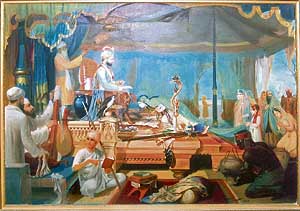Sobha Singh: Difference between revisions
Hari singh (talk | contribs) No edit summary |
Hari singh (talk | contribs) m (caps; centred) |
||
| Line 1: | Line 1: | ||
[[Image:Guru_hargobind_sahib.jpg|thumb|300px|right| | [[Image:Guru_hargobind_sahib.jpg|thumb|300px|right|{{cs|Painting by Sobha Singh, showing Noor Jahan meeting [[Guru Hargobind]] Subhash Parihar, Faridkot}}]] | ||
'''SOBHA SINGH''' (1901-1986), painter, famous especially for his portraits of the [[Gurus]], was born on 29 November 1901 in a [[Ramgarhia]] family of Sri Hargobindpur, in [[Gurdaspur district]] of the [[Punjab]]. His father, Deva Singh, had been in the Indian cavalry. In 1905, when he was only 4 yearsold, his mother Bibi Acchran died and some 12 years later, when he was about 16, his father S. Deva Singh died in 1917. At the age of 15, Sobha Singh entered the Industrial School at [[Amritsar]] for a one year course in art and craft. It is said that in 1919 he was present in [[Jalianwala Bagh]] at the time of firing. | '''SOBHA SINGH''' (1901-1986), painter, famous especially for his portraits of the [[Gurus]], was born on 29 November 1901 in a [[Ramgarhia]] family of Sri Hargobindpur, in [[Gurdaspur district]] of the [[Punjab]]. His father, Deva Singh, had been in the Indian cavalry. In 1905, when he was only 4 yearsold, his mother Bibi Acchran died and some 12 years later, when he was about 16, his father S. Deva Singh died in 1917. At the age of 15, Sobha Singh entered the Industrial School at [[Amritsar]] for a one year course in art and craft. It is said that in 1919 he was present in [[Jalianwala Bagh]] at the time of firing. | ||
Revision as of 20:55, 20 November 2007

SOBHA SINGH (1901-1986), painter, famous especially for his portraits of the Gurus, was born on 29 November 1901 in a Ramgarhia family of Sri Hargobindpur, in Gurdaspur district of the Punjab. His father, Deva Singh, had been in the Indian cavalry. In 1905, when he was only 4 yearsold, his mother Bibi Acchran died and some 12 years later, when he was about 16, his father S. Deva Singh died in 1917. At the age of 15, Sobha Singh entered the Industrial School at Amritsar for a one year course in art and craft. It is said that in 1919 he was present in Jalianwala Bagh at the time of firing.
As a draughtsman in the Indian army he served in Baghdad, in Mesopotamia (now Iraq). He left the army in 1923 to pursue an independent career in drawing and painting, initially in Amritsar. Later he moved to various other cities including Lahore (1926 & 1946)) and Delhi (1931). However, in 1949, he settled down in Andretta, a remote and picturesque village in the lap of Himalayas in the then little known place in the Kangra valley. The was the beginning the most productive period of his life - During his 38 year stay at Andretta he produced hundreds of paintings.
Sobha Singh was skilled in the western classical technique of oil painting. His themes came from the romantic lore of the Punjab, Indian epics and from the Sikh religious tradition. His paintings of Punjabi lovers Sohni and Mahinval and Hir and Rahjha became very famous. Sohni Mahinval was rated to be a real masterpiece; its impact upon the Punjabi consciousness was of a lasting nature. What gave Sobha Singh the utmost satisfaction was his paintings of the Gurus of the Sikh faith.
As he put it, "Painting the Gurus is nearest to the ultimate in the evolution of my real self". His earliest painting in the series was of the birth of Guru Nanak done in 1934. The child Nanak was depicted in Mata Tripta's lap, surrounded by his sister Nanaki and other women of the family, while Siva, Rama, Sita and the goddess Sarasvati appeared from out of the skies to shower flowers on the holy child. The motif clearly bore the influence of Christian art of the middle ages. The earliest portrait of Guru Nanak by Sobha Singh captioned "Nam khumaii nanaka charhi rahe din rat" which roughly translates to "Nanak, May the intoxication of God's name, enrapture me day and night" was painted in 1937. The Guru is shown here with eyes lowered in a mystic trance.
Several later versions of Guru Nanak's portrait by him are preserved in the Chandigarh Museum. The portrait he made in honour of the 500th birth anniversary of Guru Nanak in 1969 won the widest vogue. Likewise, he made a portrait of Guru Gobind Singh for his 300th birth anniversary in 1967 which also became very popular. Sobha Singh painted pictures of other Gurus as well Guru Amar Das, Guru Tegh Bahadar meditating in his basement chamber at Baba Bakala and Guru Har Krishan healing the sick in Delhi. Earlier in his career, he had attempted a painting depicting Queen NurJahan in the presence of Guru Hargobind, but its prints were sealed following a protest from the Muslims in 1935.
Among Sobha Singh's portraits of contemporary personalities that of Norah Richards, the matriarch of Punjabi theatre, was done with a rare delicacy and feeling. Murals by him embellish the art gallery of Parliament House in New Delhi. The 30-feet panel depicting the evolution of Sikh history features Guru Nanak with Bala and Mardana on one side, and Guru Gobind Singh in meditation on the other. Sobha Singh also tried his hand at sculpture, and did the busts of some eminent Punjabis such as M.S. Randhawa, Prithvi Raj Kapur and Nirmal Chandra. He left an incomplete headstudy of Armrita Pritam, the first most prominent woman Punjabi poetess and fiction writer.
The originals of his works are displayed in his studio at Andretta. Much acclaimed and honoured in his lifetime, Sobha Singh died in Chandigarh on 21 August 1986.
References
- 1. Madanjit Kaur, Sobha Singh, Painter of the-Divine. Amritsar, 1986
- 2. Encyclopedia of Sikhism edited by Harbans Singh ji.
